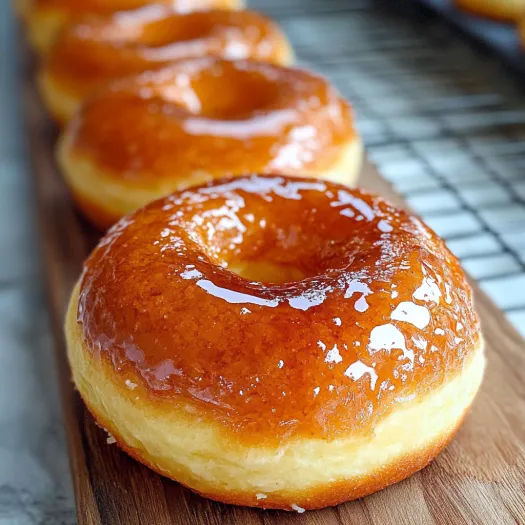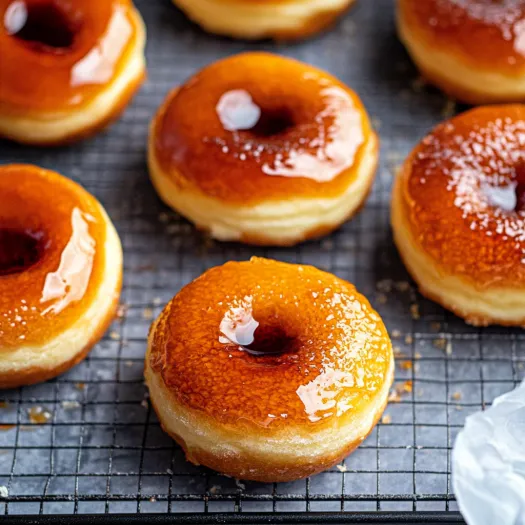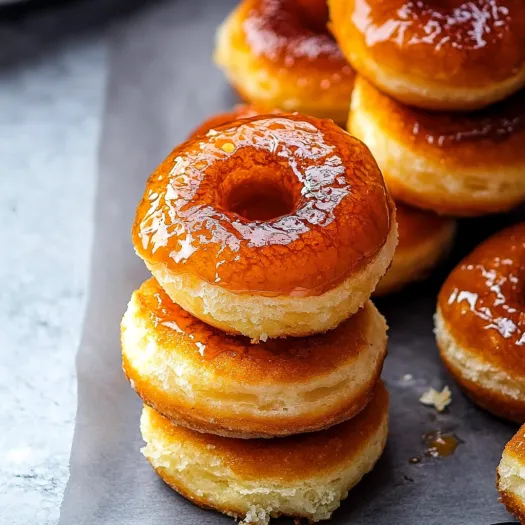 Save
Save
These homemade baked crème brûlée donuts bring together fluffy yeast-raised pastries with velvety custard filling and that trademark crackling sugar top you'd expect from the French classic. I whipped these up for my daughter's birthday breakfast gathering, and now my family won't let any celebration pass without requesting them.
I first tried making these when I wanted something fancy but wasn't in the mood to deal with hot oil. The second my kids heard that signature sugar top snap, they were totally sold on them.
What You'll Need
- Full-fat milk: Brings luxurious texture to your custard and dough – don't go for low-fat here
- Yolks from eggs: They'll make your filling incredibly smooth with that gorgeous yellow tint
- Cornstarch: Gets your pastry cream nice and thick without any strange texture
- Quick-rising yeast: Works like a charm even if you're new to baking with yeast
- Real vanilla: Skip the fake stuff for truly wonderful flavor
- Butter (unsalted): Makes everything more delicate and tasty
- Regular flour: Gives your donuts the right balance of structure and softness
- White sugar: Sweetens everything up and creates that magical crackly topping
Making These Step by Step
- Getting the filling ready:
- Warm your milk until it's steamy but not bubbling to get maximum flavor without ruining it. Slowly pour some warm milk into your egg mixture while stirring constantly – this stops the eggs from cooking too fast. Put everything back on the stove and keep whisking until it looks like thick pudding, about 5-10 minutes. Taking your time here means ultra-smooth results.
- Putting together your donut base:
- Mix warm milk with a spoonful of sugar and your yeast, then wait 5-10 minutes until it gets foamy and bubbly. This tells you your yeast is alive and working. Blend all wet stuff thoroughly before adding flour bit by bit to avoid lumps. Then knead everything for at least 5 minutes until it feels springy and smooth, which gives your donuts that perfect chewy texture.
- Letting it grow and cutting shapes:
- Put your dough in an oiled bowl somewhere warm for 45-60 minutes until it doubles in size, which builds flavor and fluffiness. Roll the dough out to 1/2 inch thick – this sweet spot gives substance without heaviness. Use a 3-inch cutter for the donuts and save leftover pieces to roll again so nothing goes to waste.
- Second growth and oven time:
- Let your cut donuts puff up again for 30-45 minutes until they look noticeably bigger – this makes them extra light. Bake at 375°F for just 10-12 minutes until barely golden on top. Keep a close eye during the last few minutes since even a little too long will dry them out.
- Adding filling and topping:
- Poke a small entry point in each cooled donut and squeeze in cold custard until it starts pushing back. For the topping, cook sugar with water and a pinch of salt until it turns amber. Using tongs, dip the tops of your filled donuts into this hot sugar mixture to create that classic crème brûlée shell.

I really love adding Madagascar bourbon vanilla to the custard because it brings subtle floral hints that make everything taste better. The first time I brought these to a family party, my nephew actually said they beat the expensive bakery ones we usually splurge on.
Fixing Caramel Issues
Don't worry too much about the caramel part. Just watch the color – aim for something between honey and amber, not dark brown which tastes bitter. If you see sugar crystals forming, just pop a lid on for a few seconds so the steam melts them away. If your caramel gets too hard while you're working, just warm it on low heat until it's dippable again.
Keeping Them Fresh
You can keep unfilled donuts in a sealed container at room temp for a couple days. After filling, they should go in the fridge and won't last more than a day before losing their magic. Try to do the sugar topping right before serving so it stays crunchy. If you need to plan far ahead, freeze the plain donuts, then thaw them out when you're ready to fill and finish them.
Try Different Flavors
Toss some lemon or orange zest into your pastry cream for a fresh twist. While heating your milk, throw in some lavender, chai spices, or coffee beans for grown-up flavors. Switch out some vanilla for almond extract if you like that marzipan taste. Another good trick is spreading a thin layer of jam under the custard for a fruit surprise inside.

When you get all the flavors and textures just right, these crème brûlée donuts will definitely steal the show at your next special event. Don't forget to savor that satisfying crack with each bite!
Common Recipe Questions
- → Why do I need to let the dough rise twice?
The two rises are key to super light, fluffy donuts. The first rise helps the yeast develop flavors and makes the dough expand with little air pockets. During the second rise, after shaping, you give the donuts even more structure. Skipping this would leave you with heavy, chewier results.
- → Can I prep the cream in advance?
Absolutely! You can get the cream ready up to three days before. Just keep it in the fridge with plastic touching the surface, so it won't form a weird skin. Not only does this save you time later, but the flavor actually deepens as it sits.
- → Why does my sugar sometimes get grainy?
Sugar crystals can act like a chain reaction and ruin the smooth caramel. To avoid this, don’t stir while heating (just swirl the pan), and make sure to brush down any stray sugar on the edges with a little water or cover the pan long enough to let steam dissolve them. If it happens, no shortcuts—start over for the best result.
- → How do I know the dough is ready after rising?
The dough should get about twice as big. Try the ‘poke’ trick: press a finger into it about half an inch deep. If the dough quickly bounces back, it needs longer. If it comes back slower or barely moves, you’re good to go!
- → How long will the donuts last?
They’re best eaten within a day of caramelizing the sugar since the topping starts to soften after that. If they’re not topped yet but filled with cream, they’ll stay good in the fridge for up to two days. Save the sugar topping step until just before eating for that perfect crunch!
- → Can I freeze these donuts?
You can freeze the donuts after baking but before filling for about a month. Defrost them at room temperature, then fill them and add the caramelized topping when ready to serve. Once filled or topped, they won’t freeze well since the texture of the cream and sugar gets weird.
